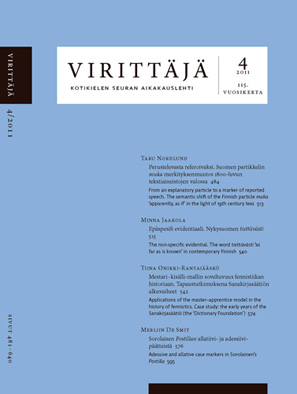Sorolaisen Postillan allatiivi- ja adessiivipäätteistä [Adessive and allative case markers in Sorolainen's Postilla]
Abstrakti
[Suomenkielinen tiivistelmä tulossa.]
---
Adessive and allative case markers in Sorolainen's Postilla
The purpose of this paper is to explain the variation between two local case markers, the adessive (-llA) and the allative (-lle), in Eric Sorolainen’s 1621–1625 Postilla. The irregular marking of these two cases is a well-known feature of Sorolainen’s texts, and is generally assumed to be rooted in the syncretism of the two case markers in Sorolainen’s Southwest Finnish home dialect. The variation cannot be seen as having mainly orthographical causes, as Sorolainen generally distinguishes carefully between e and ä, and neither as having been directly copied from Agricola, though some generalisation of the adessive case marker does occur with Agricola as well.
The corpus used consists of 400 pages from the first (1621) and 700 pages from the second (1625) part of the Postilla, amounting to roughly half of the work as a whole. All occurrences of the adessive and allative cases, with the exception of some highly grammaticised adverbs, were taken into account in this research. They were then divided into five groups corresponding with the main semantic roles which the case endings express: location, possessor and instrument (expressed with the adessive in Standard Finnish) as well as goal and recipient (expressed with the allative in Standard Finnish). Some differences between the two parts of the Postilla can be observed: irregular adessive cases are more common in the first part and irregular allatives in the second part. The division in semantic groups shows that irregular allative forms are extremely common with possessors, but extremely rare with instruments. The first phenomenon may be explained by the fact that possessor pronoun arguments and recipient/beneficiary arguments occur in otherwise very similar constructions. The second phenomenon may result from the fact that instruments and related expressions of mood do not have close equivalents with directional case markers – unlike locations (goal) and possessors (recipients). In any event, it shows that the variation in case marking with Sorolainen is not wholly arbitrary.
To explain the skewed distribution of case markers in the various semantic groups, they were divided according to lexical frequency and grouped into the various specific postpositions and personal pronouns, with other pronouns and full NPs making up the remainder. This showed that 1) most of the irregular allative cases with the ‘static’ group (location, possessor and instrument) were occurrences of the postposition pää- ‘at, onto’ and the personal pronoun me ‘we’; 2) that most of the irregular adessive cases with the ‘directional’ group (goal and recipient) occurred with non-personal pronouns and full NPs. Irregular forms were not found spread equally throughout the texts, rather they have a tendency to ‘clump’ close to one another.
As an explanation for Sorolainen’s irregular case markers, the article argues that they lie in a tendency for certain lexical items, primarily the postposition pää- and the personal pronoun me, to occur with the allative and a weaker tendency for full nouns to occur with the adessive. The lack of irregular allative case marking with expressions of instrumentality and mood is thus also explained: these are mostly expressed with full NPs. The tendency of the postposition pää- and the personal pronoun me invariably to take an allative case-marker could be based on analogical generalisation: notably, the postposition pää- is very frequent, accounting for more than a fifth of the whole material. Indirectly, however, Agricola’s example may have influenced Sorolainen as well: because of Agricola’s orthographical tendency to substitute e for ä, forms such as päle and meille are overwhelmingly frequent in Agricola’s texts, with pälä and meillä extremely rare. Sorolainen may have copied these forms directly from Agricola.
The possibility of foreign-language influence is also considered. Based on Heidi Salmi’s research on postpositional constructions in Agricola’s texts, the most common model structures for the most frequent collocations involving the postposition pää- are determined. The article posits that the Swedish models often employ the preposition på. An interlingual identification between pää- and på is plausible, as the postposition pää- was avoided as a sveticism during the 19th century language reform, while varieties of Finnish such as Meänkieli show a strong usage of the postposition pää- in accordance with Swedish models. Phonological similarity between på and pää- may also have stimulated such identification. As the Swedish preposition på is used in both static and directional expressions, the influence of the Swedish model pattern could be a factor in the blurring of the distinction between static and directional case-markers with Sorolainen.
Thus, Sorolainen’s irregular usage of adessive and allative is shown to be based on a number of factors: lexical frequency and analogical generalisation; the relationship between similar collocations in the case of possessor pronoun arguments; influence from Agricola’s texts and influence from foreign model patterns. This does not mean that the ultimate reason for Sorolainen’s irregular adessive and allative case marking is not the lack of distinction between these markers in Southwest Finnish; however, as Sorolainen does employ distinct markers for -lla, -llä and -lle, the division between these markers still needs explaining and is shown to rest on a number of factors. One common denominator of these factors is the role of ‘speech’, i.e. lexically specific collocations and constructions and their frequency, rather than ‘langue’, i.e. abstract rules governing the text as a whole. Phenomena such as allative and adessive case marking with Sorolainen appear to be situated in the no-man’s land between lexicon and syntax.






